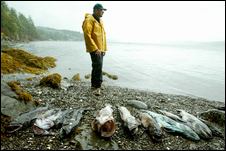
Huge jellylike colony underwater covers 'ecological dead zone'
By LISA STIFFLERP-I REPORTER
A white, cottony-looking mat of marine bacteria has been discovered blanketing underwater stretches of Hood Canal, according to research from the Skokomish Indian Tribe.
The jellylike bacteria were found this summer when divers were searching for a variety of a squishy invasive species (photo Paul Joseph Brown PI) called a tunicate. The mat covered a four-mile long "ecological dead zone" devoid of other sea life.
Researcher Wayne Palsson and colleagues at the state Department of Fish and Wildlife found dead crab and fish, including lingcod, in oxygen-poor areas of southern Hood Canal.
The 3 1/2-foot-thick layer of bacteria thrives in low-oxygen conditions and was found at depths below 35 feet in the southern region of the canal. Dead and dying sea life -- including more than 100 Dungeness crabs -- were found where the bacteria were present.
The mats are believed to still be present in the canal, and there are anecdotal reports of the bacteria dating to the 1950s, said Jan Newton, an oceanographer at the University of Washington.
"It's not surprising that those bacterial mats are there," Newton said. She suspects that they have been there undetected for a while. "What's important is Hood Canal has had really low oxygen for a long time."
Presence of the bacterial mats -- suspected to be Beggiatoa -- could be used to identify areas in ecological distress, tribal researchers suggest in a newly released report.
This week the canal experienced the most widespread fish kill recorded for the waterway, wiping out countless shrimp and crabs, and lingcod, flounder, sand lance and other fish. The suffocated creatures were found in a region west of where the bacteria were found.
"We are deeply concerned that more of these dead zones may exist in other parts of southern Hood Canal," Dave Herrera, a fisheries policy expert for the Skokomish Tribe, in a statement. "Our treaty-protected resources and tribal economy are threatened by the declining health of Hood Canal."
The dead zones are blamed on high levels of nutrients such as nitrogen washing into the poorly flushed fjord. The nutrients and sunny weather trigger algal blooms. The plants die and are consumed by bacteria that rob oxygen from the water. Leaking septic systems and fertilizers as well as ocean water and certain trees could all be contributing nitrogen to the canal.
The bacterial mats, which produce a sulfuric smell, are not believed to be the cause of the low oxygen levels, Newton said, but rather taking advantage of the anoxic conditions.
The area where the bacteria were found, which included waters offshore of Twanoh State Park near Belfair, is where the canal's lowest oxygen levels have consistently been measured.
A coalition of 38 groups, including state agencies, universities, local and tribal governments and non-profit organizations, has formed the Hood Canal Dissolved Oxygen Program to try to solve the oxygen problems.
P-I reporter Lisa Stiffler can be reached at 206-448-8042 or lisastiffler@seattlepi.com.
No comments:
Post a Comment